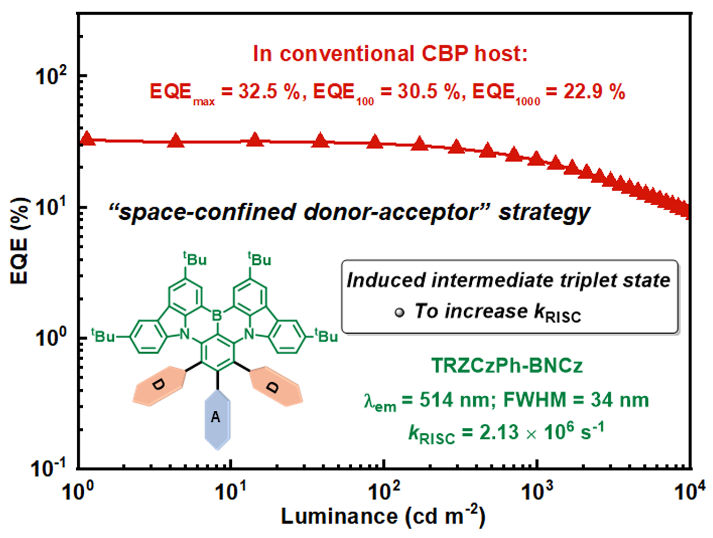Multi-resonance boron-nitrogen-containing thermally activated delayed fluorescence (MR-TADF) emitters have experienced great success in assembling narrowband organic light-emitting diodes (OLEDs). However, the slow reverse intersystem crossing rate (kRISC) of MR-emitters (103-105 s-1) that will lead to severe device efficiency roll-off has received extensive attention and remains a challenging issue.
To address this issue, Jingsong You/Zhengyang Bin et al. in the College of Chemistry, Sichuan University, put forward a "space-confined donor-acceptor (SCDA)" strategy to accelerate RISC process. The introduction of SCDA units onto the MR-skeleton induces intermediate triplet states, which leads to a multichannel RISC process and thus increases kRISC. As illustrated examples, efficient MR-emitters have been developed with a sub-microsecond delayed lifetime and a high kRISC of 2.13 × 106 s-1, which enables to assemble high-performance OLEDs with a maximum external quantum efficiency (EQEmax) as high as 32.5% and an alleviated efficiency roll-off (EQE1000: 22.9%).

This work is published on Angewandte Chemie International Edition, titled as “Space-Confined Donor-Acceptor Strategy Enables Fast Spin-Flip of Multiple Resonance Emitters for Suppressing Efficiency Roll-Off”. Sichuan University is top institute in the address list. Prof. Jingsong You and associated Prof. Zhengyang Bin are corresponding authors, and Mr. Yang Liu is the first author. This work is financially supported by financial support from the National NSF of China and the Sichuan Science and Technology Program as well as the Institutional Research Fund from Sichuan University. Thanks for Prof. Dongge Ma and Prof. Dezhi Yang from South China University of Technology for the assistance with horizontal dipole ratio measurements and Prof. Haoyuan Li from Shanghai University for the assistance with theoretical calculations.
Links to: https://doi.org/10.1002/anie.202210210
